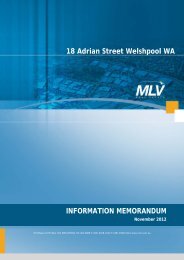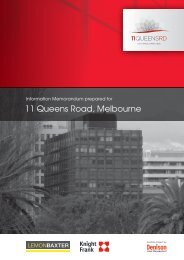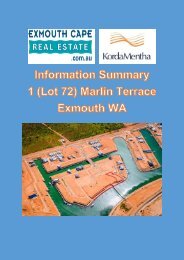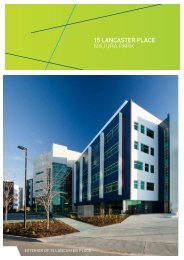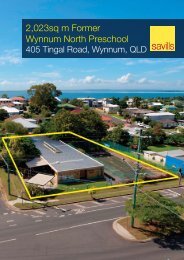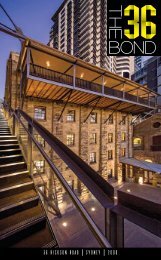FIONA STANLEY HOSPITAL - RETAIL
FIONA STANLEY HOSPITAL - RETAIL
FIONA STANLEY HOSPITAL - RETAIL
- No tags were found...
You also want an ePaper? Increase the reach of your titles
YUMPU automatically turns print PDFs into web optimized ePapers that Google loves.
A N I N V I T A T I O N T OT E N D E R F O R<strong>FIONA</strong> <strong>STANLEY</strong><strong>HOSPITAL</strong> - <strong>RETAIL</strong>M U R D O C HW E S T E R N A U S T R A L I AR E T A I L P R E M I S E ST O B E D E V E L O P E D A TF I O N A S T A N L E Y H O S P I T A LM U R D O C H
TABLE OFCONTENTS01 INTRODUCTION 302 LEASE CONDITIONS 703 REQUIREDINFORMATION 804 ENVISAGED PROJECTPROGRAM 1205 ATTACHMENTS 145.1 - <strong>FIONA</strong> <strong>STANLEY</strong> <strong>HOSPITAL</strong>LOCATION PLAN5.2 - <strong>RETAIL</strong> PREMISE/S -INDICATIVE AREAS5.3 - FOOD AND NUTRITIONPOLICY FOR WA HEALTH SERVICEAND FACILITIES
01INTRODUCTIONThe State Government is developing the Fiona Stanley Hospital in Murdoch, Western Australiain conjunction with Serco (as Facilities Manager).The $2 billion Fiona Stanley Hospital is the largest building project ever undertaken by the StateGovernment. It will:be the size of four city blocks.cover 150,000sqm of floor space over five main buildings.have 6,300 rooms and 783 beds, including 140 rehabilitation beds.utilise state-of-the-art technology in every level of the Hospital.feature more than five hectares of natural bushland, landscaped parks, internalgardens, courtyards and plazas.offer 3,600 car parking bays.When it opens in early-2014, Fiona Stanley Hospital will be the major tertiary Hospital in thesouth metropolitan area and will offer comprehensive health care services to communitiesacross Western Australia.Located at the centre of a health, education and research precinct at Murdoch, Fiona StanleyHospital is set to benefit from excellent links to local education and health providers and astate-of-the-art on-site medical research facility to be built by the Western Australian Institute forMedical Research.The design of the Hospital is based on national and international research and principles ofenvironmental sustainability, accessibility and healing.The main Hospital will have a central concourse, which will be the length and width of Perth’sHay Street Mall. It will link all major areas of the Hospital.Travel to and from Fiona Stanley Hospital will be convenient for staff, patients and visitorsbecause of the close proximity to Perth city – which is only 15 kilometres away – and theMurdoch bus / rail interchange. The Hospital is bordered by three major access roads –Kwinana Freeway, Murdoch Drive and South Street.Fiona Stanley Hospital 3
Regular, direct public transport services will be available between Murdoch interchange and theHospital. During peak hours, trains will arrive at Murdoch Station every five minutes, with twotrains every 15 minutes at non-peak times. A bus will pass by the Hospital every two minutes atpeak times and every five minutes at non-peak times.The Hospital is easily accessed through a network of pedestrian and cycling paths with end-oftripfacilities at the site.Patients, visitors and staff will have access to 3,600 parking bays in basement, ground leveland multi-storey parking areas.Retail and food catering tenancies in Fiona Stanley Hospital’s Retail Precinct will benefit from alarge volume of pedestrian traffic.Fiona Stanley Hospital’s Retail Precinct may consist of two retail tenancies, two cafes, five foodcatering tenancies adjacent to common dining area and three kiosks (9-18 square metres insize). Anticipated tenants include, but are not limited to, combinations of the following:A retail pharmacy;A Lotto/newsagency tenancy;Dry cleaning services;A convenience store providing items such as toiletries andbasic food items;A florist;A cafe outside the main entrance of the main Hospital Building - ‘Plaza Cafe’;Catering tenancies retailing a variety of food and beverages with a dining area in themain Hospital building;A cafe adjacent to the Rehabilitation Building; andVending machines.The Retail Precinct is required to be ready for operation from 23 December 2013. A stagedopening program is to be confirmedSee maps at -http://www.fionastanley.health.wa.gov.au/home/See fly through video of facility at -http://www.youtube.com/watch?v=Vpf3pO5qRYwFiona Stanley Hospital 4
THE PREMISESFiona Stanley Hospital has provision for one (1) to two (2) Retail premises at the forecourt entryof the main Hospital building.The proposed floor layout is attached at 5.2 (estimated internal size between 69 up to 145square metres).DEVELOPMENT APPROACHESFiona Stanley Hospital will provide a building shell for the Retail Premise/s which will includethe following:AreaArchitectural‘Retail Premises’ - Main Hospital building, main entryRetail PremisesGeneralExternal perimeter glazed facade/shop front provided.Concrete for set down 50mm with bull float finish provided.No ceilings provided.Internal finishes by tenant.Fitted out to minimum Building Code of Australia (BCA)requirements.Internal walls provided lined with plasterboard, set but notpainted.No further storage area/s provided on site.Structural Slab setdown 50mm provided.Mechanical ventilation No exhaust systems provided. Heating and cooling systems pipework capped off withinpremises and metered. Metering picked up by IntegratedExtra Low-Voltage system (IELVS). One for each tenancyprovided.Fiona Stanley Hospital 5
Heating Ventilation Air-conditioning (HVAC) by tenant.Chilled Water As detailed under ‘Ventilation’.Electrical Power andLighting Board in each tenancy provided, (metered to class 1). 10 pair direct connection lines to each tenancy provided. Lighting to Building Code of Australia (BCA) minimumstandards to tenancy provided.Hydraulics Cold water valve in ceiling void and capped & valved off (2mwithin the space provided). Sewer branches capped off in 2 points in the space (i.e: 1point for each tenancy in wall provided.) No Floor Waste Gully (FWG) provided. Nil gas provided. No hot water provided.Information andCommunicationTechnology (ICT)Connectivity to data points available.Fire protection services Sprinkler main and void protection with plugged branchesprovided to cover future ceiling installation to Building Codeof Australia (BCA) minimum. Fire alarm devices provided to cover void protection andceiling to Building Code of Australia (BCA) minimum.Security No security provided.Integrated Extra-LowVoltage System (IELVS)Cabling for tenancy water meter provided.Cabling for tenancy board power meter provided.Metering of all utilities for each tenancy provided.All other fitout works will be the Lessee’s responsibility. The Lessee is to fit out the premises inaccordance with the Design Fitout Guide for Fiona Stanley Hospital, which will be available topotential tenants who qualify to proceed through the tender process following this initialInvitation to Tender.Fiona Stanley Hospital 6
02LEASE CONDITIONSDraft lease documents which will form the basis of the Agreement to bereached between the parties, will be available to potential tenants who areadmitted, and elect to proceed, beyond this Invitation to Tender.We take this opportunity to bring to the Lessee’s attention the following:Being a retail shop lease under the terms of the CommercialTenancy (Retail Shops) Agreements Act 1985, it is proposed thatthe lease is a Gross Lease. Consumables are on a user pay basis.Fiona Stanley Hospital will seek a Bank Guarantee for the Leaseof six (6) months gross rent plus GST.The Lessee will be operating in the clinical environment of a majortertiary Hospital. The Lessee will be expected to maintain highstandards of operating procedures to reflect this environment, andwork with the Property Manager to ensure the provision of theRetail Service does not disrupt the availability of the site or causea disruption to Health Functions.The Lease will be between the State Government and the Lesseedirect.The Lessee agrees that all employees will be subject to the sameHuman Resource requirements as all Serco and State Governmentstaff employed on the site.Fiona Stanley Hospital 7
03REQUIRED INFORMATIONPotential tenants of Fiona Stanley Hospital are required to submit the following information:LESSEE QUALIFICATIONSAs a part of your submission please provide the following information:1. Details of the legal entity being proposed as Lessee and the name under which it willtrade, including ABN and registered address if applicable.2. A description of the type of business to be operated from the premises, includingproduct lines (see attachment 5.3 Food & Nutrition Policy for WA Health Services andFacilities for any food products) and a proposed product list with suggested pricepoints.3. Background information on the Lessee’s operations including number of outletselsewhere, years of experience in the industry, size and financial standing of the Lesseegroup and details of key personnel.4. Details of the Guarantor of the Lease - including full names and addresses and fullparticulars of their business and operating experience.VISUALS OF THE PREMISESPhotographs or sketches of other operations of the Lessee which best exemplify what isproposed for this site e.g. External signage, fitout, design, quality of fittings etc.COMMERCIAL TERMSFiona Stanley Hospital requires the Lease terms as outlined on the schedule on the followingpage.Fiona Stanley Hospital 8
Description of the PremisesTerm of Lease:Commencement Date:Option Term:Gross Annual Rent:Rent Review:Fitout Co-ordination FeeIntended use:Trading Hours:‘Retail Premises’ Fiona Stanley Hospital,having a retail area of __ square metresapproximately (subject to survey).A term of 7 years from theCommencement Date.The Retail Precinct is required to be readyfor operation from 23 December2013. A staged opening program is tobe confirmed. The Lessee will be grantedsix (6) weeks prior to this date for fitoutand acceptance testing purposes free ofrent.Negotiable.The Gross Rent to be nominated by theprospective Retailers *The rent shall be increased annually onthe anniversary of the CommencementDate throughout the term or any extensionthereof (if granted) by 5% per annum.Should an option period be granted,Fiona Stanley Hospital may require amarket review at the commencement ofthe Option Period.$5,000 plus GST.Retailing as a ___________.It is envisaged that the ‘Retail Premises’will offer service, at a minimum, between6.30am and 6.30pm, seven days a week.* Fiona Stanley Hospital reserves the right to structure the Lease as a semi-gross Lease plus thepayment of a Services Levy if deemed appropriate. Consumables, (for example, power) arepayable in addition to the rent and service levy.* Fiona Stanley Hospital reserves the right to assess each tender on a balance of the quality ofthe submission and the Gross Annual Rent offered.Fiona Stanley Hospital 9
KEY TERMS AND SPECIFICATIONS FOR <strong>RETAIL</strong> SERVICE(a) The price for each product offered is clearly displayed at each point of sale for the product.(b) All users are served and delivered the product in a prompt, friendly and efficient manner.The Lessee acknowledges that the Retail Service is to be provided in a sensitive environmentwhere people may have special needs and require an elevated level of care and considerationof safety.(c) A Point of Sale system (charge card) is available to all Inpatients and staff which interfaceswith the Patient Entertainment System, but is clearly differentiated from the Patient CateringService provided by Serco.ADDITIONAL KEY TERMS AND SPECIFICATIONS FOR CATERING SERVICE (IF APPLICABLE)The Lessee must ensure that the following relevant outcomes are achieved if providing a RetailCatering Service:(a) The Lessee must comply with the Health Policy entitled “The Healthy Options WA: Food andNutrition Policy for WA Health Services and Facilities” (attached at 5.3).(b) The premises operate within HACCP guidelines and all food and beverages are procured,prepared and served in accordance with all HACCP principles.(c) All Retail Catering Equipment (owned by the Lessee) is provided, maintained, stored,cleaned and replaced in accordance with the relevant manufacturer’s instructions and GoodIndustry Practice.(d) The provision of a range of meals, snacks and hot and cold beverages (that are appropriatefor the different types of Hospital Users) are available for purchase by Hospital Users and:(i) are presented in an appetising manner; and(ii) offer an appropriate choice and alternatives, including with respect to the type of food andbeverages offered, the size of the portions offered, and the cost of the menu.(e) The premises provides:(i) a Take-Away service;(ii) a Pre-ordered (for both collection and delivery) service; and(iii) a Fast Service.(f) All crockery, cutlery and trolleys used in the provision of the ‘Retail Premises’ is aestheticallyappealing and functionally appropriate for the meal it is accompanying and is clean and freefrom any:(i) chips and cracks;(ii) distortions;(iii) blemishes and stains;Fiona Stanley Hospital 10
(iv) fading;(v) tarnish and rust;(vi) obvious signs of repair;(vii) dirt and food residue; and(viii) obvious signs of breakage.(g) There is potential for the Lessee of the ‘Retail Premises’ to also operate mobile food andbeverage carts, and provide catering of meetings and functions within Fiona Stanley Hospital.LICENCES AND OTHER REQUIREMENTSThe Lessee must ensure that they obtain and hold at all times the certificates, licences,consents, permits, approvals, and requirements of organisations having jurisdiction inconnection with or necessary for the carrying out or operation of the Lessee’s business orundertakings in connection with the Lease. Potential tenants must be able to demonstrate:(i) any necessary licenses and registrations are held, and are required to be submitted to aregister to be maintained by Serco’s Property Manager (obtaining all licenses and approvalsare the Lessee’s responsibility);(ii) sufficient resources to provide the services the subject of the relevant Lease;(iii) ability to present and maintain their retail areas in accordance with the Design Fitout Guideand Serco’s Operational Procedures (to be provided to successful tenders).Fiona Stanley Hospital 11
04ENVISAGED PROJECT PROGRAMFiona Stanley Hospital is seeking to select a preferred operator/s for each or both RetailPremises from the submissions received and then finalise the terms of the Offer to Lease andLease. This will occur through a tender process following this open Invitation to the market.An anticipated program for the project is as follows:Submissions in response to this “Invitation to Tender” in triplicate or electronic version to belodged with Mr Fred Clohessy, Mr Mickey Janssen or Ms Tiahn Jarrett, Level 2 London House,216 St George’s Terrace, Perth WA 6000 by 8 March 2013, strictly closing 4pm WST.Fred ClohessyAssociate Director – RetailServicesCBREfred.clohessy@cbre.com.au(08) 9320 00250408 094 978Mickey JanssenSenior Negotiator - RetailServicesCBREmickey.janssen@cbre.com.au(08) 9320 00860401 619 641Tiahn JarrettProfessional Assistant - RetailServicesCBREtiahn.jarrett@cbre.com.au(08) 9320 0071Assessment of submissions to this “Invitation to Tender” by 22 March 2013.A short list of successfully qualified parties will be provided with more detailed site informationand draft lease documents in order to continue through the tender process.The preferred Retail premises operator/s will proceed to negotiations with the view of finalisingthe Lease and sign the Agreement to Lease by 30 June 2013.Fiona Stanley Hospital 12
Please note that there is no obligation on Fiona Stanley Hospital to progress any of thesubmissions and all final recommended lease parties are subject to approval. Fiona StanleyHospital has the right to:(i)(ii)use their absolute discretion in the selection of the proposed operatoramend the conditions of the Lease following discussions with the preferred operatorWhilst every attempt has been made to provide accurate information to the invited parties,Fiona Stanley Hospital takes no responsibility for any costs incurred by those parties makingsubmissions arising from errors or omissions in the information provided. Furthermore, theparty making a submission acknowledges that it does so entirely at its own cost in all events.Fiona Stanley Hospital 13
05ATTACHMENTS5.1 - Location plan depicting the position of the Retail premise/s5.2 - Plan of the potential Retail premise/s.5.3 - Food and Nutrition Policy for WA Health Service and Facilities.Fiona Stanley Hospital 14
5.1 <strong>FIONA</strong> <strong>STANLEY</strong> <strong>HOSPITAL</strong> - LOCATION MAPFiona Stanley Hospital 15
5.2 ‘<strong>RETAIL</strong> PREMISE/S’ - INDICATIVE AREASFiona Stanley Hospital 16
5.3 FOOD AND NUTRITION POLICY FOR WA HEALTH SERVICE AND FACILITIESFiona Stanley Hospital 17
Healthy Options WAFood and Nutrition Policy forWA Health Services and Facilities(Amended April 2009)
AcknowledgementsThe Healthy Options WA: Food and Nutrition Policy for WA Health Services and Facilities adapts elementsfrom Queensland Health’s A Better Choice – Healthy Food and Drink Supply Strategy for Queensland HealthFacilities (2007) and the Queensland Departments of Health and Education, Training and the Arts, SmartChoices – Healthy Food and Drink Supply Strategy for Queensland Schools (2005). Both strategies buildon the NSW Department of Health and NSW Department of Education and Training Fresh Tastes @ SchoolNSW Healthy School Canteen Strategy: Canteen Menu Planning Guide (2004, revised 2006).The Healthy Options WA: Food and Nutrition Policy for WA Health Services and Facilities has beendeveloped through review of best practice and relevant evidence, consultation and input from a HealthyOptions WA Project Advisory Group.The Department of Health WA wishes to thank and acknowledge the contribution of all management andstaff who assisted in the development of this strategy.Suggested citation:Department of Health. Healthy Options WA: Food and Nutrition Policy for WA Health Services and Facilities.Perth, Western Australia: Western Australian Government; 2009 (amended).
ForewordThe link between diet and health is unequivocal. Good nutrition is a key contributor to health andfitness, the optimal growth and development of our children and the prevention of obesity and arange of chronic diseases such as type 2 diabetes, cardiovascular disease and some cancers. Ahigh quality diet is also an essential component of an effective health care plan for many medicalconditions.WA Health services can play a vital leadership role in supporting the health workforce andcommunity visitors to make healthy dietary choices. By ensuring the availability of tasty,interesting and affordable healthy foods and drinks within health care facilities, the policysupports and reinforces the nutrition advice provided by medical staff, health professionals andcommunity education programs.This version of the Healthy Options WA: Food and Nutrition Policy for WA Health Servicesand Facilities provides updated guidelines for the supply of foods and drinks in health careestablishments. I would like to acknowledge the considerable changes already achieved by WAHealth facilities since the original policy was implemented. The new policy aims to build on thesesuccesses while ensuring that a range of food choices remains available.The updated Healthy Options WA policy will be mandatory in all WA Health services and facilitiesfrom 1 October 2009, with health services able to tailor the choice of specific products to meetlocal needs.The Healthy Options WA policy reflects the Government’s commitment to improving the healthof the Western Australian community through provision of comprehensive and health promotinghealth services. The policy is an excellent opportunity for our hospitals and health services tomodel, educate and support healthier food and drink choices.Hon Dr Kim Hames MLAMinister for HealthI10617 Healthy Options WA Policy.indd 1 14/5/09 10:10:02 AM
ContentsOverview...........................................................................................................................................2Rationale for the policy.....................................................................................................................3Health reform in Western Australia...............................................................................................4Food and drink outlets in health services.....................................................................................4Evidence base and development.................................................................................................5Healthy Options WA: Food and Nutrition Policy for WA Health Services and Facilities..................6Aims and objectives......................................................................................................................6WA Heath service food and drink outlets affected........................................................................6The role of WA Health food outlets...............................................................................................7What’s on the menu for WA Health services and facilities?.............................................................8Application of the policy................................................................................................................8Definition of Green, Amber and Red .............................................................................................10Green foods and drinks – Healthy options.................................................................................10Amber foods and drinks.............................................................................................................12Red foods and drinks..................................................................................................................14Other considerations......................................................................................................................16Special considerations for children.............................................................................................16Provision of water.......................................................................................................................17Contracts for food supply with private companies/food outlets under lease..............................17Monitoring of compliance with restriction of Red items..............................................................18Appendix 1:..Development of the policy and guidelines................................................................19Appendix 2:..Nutritional criteria to distinguish Red and Amber foods and drinks..........................21Appendix 3:..Guidelines for freshly prepared meals......................................................................24110617 Healthy Options WA Policy.indd 1 14/5/09 10:10:02 AM
OverviewWA Health has reviewed the policy guidelines for the provision of food and drinks in healthestablishments within the state. The revised policy will be mandatory from 1 October 2009. Priorto that date, WA health service food outlets are expected to work towards full compliance.The Healthy Options WA: Food and Nutrition Policy for WA Health Services and Facilities aimsto enhance, improve and maintain the health of staff and the broader community by helpinghealth care establishments to support and model good nutrition and healthy eating options. Thisapproach to preventing and managing disease is in keeping with the World Health Organisation’s(WHO) Health Promoting Hospitals approach 1 .Under the policy, all food outlets available to staff and visitors within WA Health services,hospitals and facilities provide and actively promote a greater selection of healthy nutritiousfood and drink choices and limit the supply of less healthy options. The policy does not apply toinpatient or aged care resident meals.The Healthy Options WA: Food and Nutrition Policy for WA Health Services and Facilities isconsistent with the ‘traffic light’ food categorisation system currently being used for schoolcanteens by the Western Australian Department of Education and Training Policy and Standardsfor Healthy Food and Drink in Public Schools, 2006.This document outlines the rationale for the policy, its aims and objectives, the services towhich the policy applies and the role of WA Health food outlets in its implementation. Thedocument also provides details of the nutrient criteria and guidelines for food supply and foodcategorisation with special considerations for children and freshly prepared meals.1World Health Organization, Health promotion in hospitals: evidence and quality management, WHO Regional Office for Europe, 2005.210617 Healthy Options WA Policy.indd 2 14/5/09 10:10:02 AM
Rationale for the policyThere is compelling evidence that eating a balanced diet is important to health throughout life,aids recovery from illness and prevents or delays disease progression. Good nutrition alsocontributes to vitality and energy levels, good mental health and social functioning and helpsmaintain independence in later years.Along with smoking, physical inactivity and harmful alcohol use, poor eating habits are asignificant risk factor for a number of preventable chronic diseases, including but not limitedto cardiovascular disease, type 2 diabetes, stroke, some cancers and musculoskeletalconditions. Diets high in saturated fat, salt and sugar and low in plant foods are associated withhypertension, elevated blood lipids and cholesterol, and obesity 2 .Obesity is a major risk factor for a range of chronic conditions and mental health problems inadults and children. The rate of overweight and obesity has doubled amongst both Australianadults and children in the last two decades. In 2000, approximately two in three male, and one intwo female Western Australians over 25 years of age were overweight or obese 3 . In 2003, 22%of male West Australian school children aged 7 to 16 years and 28% of females were overweightor obese 4 .While there is some evidence that the Australian diet is improving, many people do not eat therecommended levels of many key dietary items, such as fruit, vegetables and cereals 5 . Energy(kilojoules) and sugar intake have increased among adults and children, mainly due to increasedconsumption of soft drink, high-energy snack foods, fast food and confectionery. The increase inoverweight and obesity has been linked to increased energy intake, the increased energy densityof many foods and the ready availability of energy dense foods and drinks 6,7 .A significant proportion of the Australian food dollar is now spent on foods purchased andconsumed outside the home 8 . It is vital that people are able to make healthy choices whenbuying from food outlets outside the home, through being able to access nutritious foods that arenot high in fat and sugar.2Department of Health, Western Australian Health Promotion Strategic Framework 2007-2011, Department of Health, Perth, 2007.3D Dunstan, P Zimmet, T Welborn, R Sicree, T Armstrong, R Atkins, et al, The Australian Diabetes, Obesity and Lifestyle Study(AusDiab), International Diabetes Institute, Melbourne, 2001.4Premier’s Physical Activity Taskforce, Children and adolescent physical activity and nutrition (CAPANS) survey 2003 report,Government of Western Australia, Perth, 2005.5Epidemiology Branch, Analysis and Performance Reporting, Department of Health Western Australia, 2006 Western Australian Healthand Wellbeing Surveillance System, 2006 (unpublished).6C Stubbs, A Lee, The obesity epidemic: Both energy intake and physical activity contribute, Medical Journal of Australia, vol 181, no 9,2004, pp 489-91.7Australian Institute of Health and Welfare, Risk factor monitoring. A rising epidemic: obesity in Australian children and adolescents, RiskFactors Data Briefing Number 2, 2004. Available at www.aihw.gov.au/riskfactors/data_briefing_no_2.pdf8R Stanton, ‘Nutrition problems in an obesogenic environment’, Medical Journal of Australia, vol 184, no 2, 2006, pp 76-79.310617 Healthy Options WA Policy.indd 3 14/5/09 10:10:02 AM
Health reform in Western AustraliaA key element of health reform in Western Australia, outlined in the Western AustralianDepartment of Health’s Strategic Intent 2005–2010 9 , has been to increase the emphasis of thehealth system on the prevention of chronic disease through the promotion of healthy lifestyles,particularly physical activity, good nutrition, non-smoking and low risk alcohol use.Promotion of healthy food choices is a key strategic direction within the Western AustralianHealth Promotion Strategic Framework 2007-2011 10 . The framework identifies the need toincrease access to affordable nutritious food and to develop settings and environments thatsupport healthy nutrition through policy, food access and education approaches. In particular, theFramework identifies the need to increase healthy food supply in settings such as health carefacilities, workplaces, childcare and schools.This approach has also been recommended in other state and national policy documents, namelyHealthy Weight 2008 Australia’s Future: A National Action Agenda For Children and Young Peopleand Their Families 11 , Healthy Weight for Adults and Older Australians: A National Action Agendato Address Overweight and Obesity in Adults and Older Australians 2006–2010 12 and Acting onAustralia’s Weight: A Strategic Plan for the Prevention of Overweight and Obesity 13 .Food and drink outlets in health servicesHospital-based food outlets and vending machines are a major source of meals, beverages andsnacks for outpatients, visitors and staff within health establishments. Food outlets are typicallyopen during the day and often run by volunteers. After hours, staff, patients and visitors rely onvending machines to provide food and drink when other outlets are closed.WA Health facility food outlets are owned, leased and operated by a mixture of agencies,including WA Health, hospital foundations, hospital auxiliaries and volunteer groups and privatecompanies under contract.While many health services serve some healthy choices and have made significantimprovements to the options available over the last two years, most still offer high fat, energydense and high sugar foods and a range of high sugar soft drinks.WA Health is committed to the wellbeing of its staff. Its services and facilities have aresponsibility to ensure that their workforce and community visitors can access healthy meals,beverages and snack foods.Health services have the opportunity to reinforce the health and nutrition messages beingpromoted by health care professionals and health promotion programs and campaigns. Theycan become models for other workplaces and settings by providing and promoting affordableand nutritious foods and drinks in all premises and facilities.9Department of Health, Strategic Intent 2005-2010, Department of Health, Perth, 2004.10Department of Health, Western Australian Health Promotion Strategic Framework 2007-2011, Department of Health, Perth, 2007.11Commonwealth Department of Health and Ageing, Healthy Weight 2008, Australia’s Future – A National Action Agenda For Childrenand Young People and their Families, Australian Government, Canberra, 2003.12Commonwealth Department of Health and Ageing, Healthy Weight for Adults and Older Australians – A National Action Agenda toAddress Overweight and Obesity in Adults and Older Australians 2006 – 2010, Australian Government, Canberra, 2006.13National Health and Medical Research Council (NHMRC), Acting on Australia’s Weight - A Strategic Plan for the Prevention ofOverweight and Obesity, Australian Government, Canberra, 1997.410617 Healthy Options WA Policy.indd 4 14/5/09 10:10:02 AM
Evidence base and developmentThe Healthy Options WA: Food and Nutrition Policy for WA Health Services and Facilitiesreflects the evidence-based Dietary Guidelines for Australian Adults, the Dietary Guidelines forChildren and Adolescents in Australia and the Australian Guide to Healthy Eating.The policy utilises the ‘traffic light’ system of food classification for identification and promotionof a healthy food supply that has been adopted by a number of government agencies in thefollowing initiatives:New South Wales - Fresh Tastes @ School NSW Healthy School Canteen Strategy: CanteenMenu Planning Guide (NSW Departments of Health, and Education and Training, 2006);and Healthier Food and Drink Choices for Staff and Visitors in NSW Health Facilities (NSWDepartment of Health, 2007).Queensland - Smart Choices – Healthy Food and Drink Supply Strategy for QueenslandSchools (Queensland Departments of Health and Education, Training and the Arts,2005); and A Better Choice – Healthy Food and Drink Supply Strategy for QueenslandHealth Facilities (Queensland Health, 2007).Western Australia - Policy and Standards for Healthy Food and Drink in Public Schools(Western Australian Department of Education and Training, 2007).This ‘traffic light’ system classifies foods and drinks according to nutrient density into:Green foods and drinks that can be eaten daily and at every meal. These are importantsources of nutrients and low in saturated fat, added sugar and salt.Amber foods and drinks have some nutritional value, contain moderate levels of saturated fat,added sugar or salt and should be eaten in moderation.Red foods and drinks are energy dense and nutrient poor and are high in saturated fat, sugaror salt. They can contribute to excess energy intake if consumed in large amounts or on afrequent basis. They should only be consumed occasionally and will be limited in WA Healthservices.The nutrient criteria for the Healthy Options WA: Food and Nutrition Policy for WA HealthServices and Facilities were based on the Fresh Tastes @ School NSW Healthy School CanteenStrategy: Canteen Menu Planning Guide, A Better Choice – Healthy Food and Drink SupplyStrategy for Queensland Health Facilities and the FOCiS (Federation of Canteens in Schools)National Criteria for Product Registration for school canteens.More information about the development of the policy can be found in Appendix 1.510617 Healthy Options WA Policy.indd 5 14/5/09 10:10:03 AM
Healthy Options WA: Food and Nutrition Policy forWA Health Services and FacilitiesAims and objectivesThe Healthy Options WA: Food and Nutrition Policy for WA Health Services and Facilities aimsto enhance, improve and maintain the health of staff and the broader community by providinghealth care establishments that support and model good nutrition and healthy eating options.The objectives of the policy within WA Health services and facilities are to:Increase the range and availability of healthy food and drink options from vendingmachines, ward trolleys and food outlets.Promote healthy food and drink options at point of sale and support ongoing healthpromotion and education.Reduce unhealthy food and drink options in food outlets to no more than 20% of foodoffered or displayed by the outlet.WA Health service food and drink outlets affectedThe Healthy Options WA: Food and Nutrition Policy for WA Health Services and Facilitiesapplies to all services, facilities and establishments owned or leased by WA Health and involvedin the provision of prevention, treatment, rehabilitation and palliative services to patients andthe general community. This includes all hospitals, community health centres and clinics,rehabilitation services and policy and administration agencies involved in the support anddelivery of health services.The new guidelines apply to all food outlets, vending machines and food and drink sources thatare available to staff and visitors in these facilities. These outlets are currently provided by amixture of hospital, volunteer/auxiliary and contracted food vendors.They include:Cafes and coffee shops.Food outlets and kiosks.Food and drink vending machines.Staff cafeterias and canteens.Ward trolley services for patients and visitors.Internal and external fundraising initiatives, events and prizes.Professional and business catered functions and meetings.The policy applies to all food and drinks, whether freshly made on the premises or supplied prepackedor processed.610617 Healthy Options WA Policy.indd 6 14/5/09 10:10:03 AM
Where food and beverage outlets (such as cafes and kiosks) are provided under existinglong-term contracts or leases, the new policy guidelines will be implemented as part of thedevelopment of new, renewed or renegotiated food service contracts and leases as theopportunity arises. All new contracts for the provision of foods or beverages to WA Healthservices and facilities negotiated after 1 October 2009 must comply with the policy guidelines.The Healthy Options WA: Food and Nutrition Policy for WA Health Services and Facilities doesnot apply to inpatients or aged care resident meals. Health services have their own food andnutrition policy for inpatient nutrition based on the Nutritional Specifications for Hospital FoodService - Department of Health, Western Australia (2005), and best practice guidelines for themanagement of clinical conditions. Aged care resident meals need to comply with the Standardsfor Aged Care Facilities (Department of Health and Ageing, 2004).The Healthy Options WA: Food and Nutrition Policy for WA Health Services and Facilities doesnot apply to staff social functions or to food and drink items that staff bring from home.Children may be visitors or clients of paediatric services. Additional recommendations applyfor children due to their specific nutritional needs and are outlined in the ‘Other Considerations’section.The role of WA Health food outletsThe role of WA Health food outlets is to support healthy eating by providing a food servicefor visitors and staff that is affordable, promotes healthy food and meets their nutritionalrequirements.When implementing the Healthy Options WA: Food and Nutrition Policy for WA Health Servicesand Facilities, health service managers should consider the following:The policy is primarily concerned with the provision of healthy food and drinks to staff andhealth service visitors.Health services should provide consistent and accurate information and messages abouthealthy diet.Short-term profit should not come before the health of staff and visitors.While some retail food outlets managed by private companies may initially be able to provideunhealthy options under their current contracts, health services will need to negotiatecompliance with the policy when developing new or renegotiating contracts.Each health service will need to implement the policy taking into account the unique conditionswithin each facility with respect to the nature of food and drink outlets, existing food supplycontracts and needs of the health workforce.Health services will be able to access support materials and information through the Departmentof Health’s Healthy Options WA website.710617 Healthy Options WA Policy.indd 7 14/5/09 10:10:03 AM
What’s on the menu for WA Healthservices and facilities?The Healthy Options WA: Food and Nutrition Policy for WA Health Services and Facilities isbased on a ‘traffic light’ system to classify foods and drinks according to their nutrient content.Specific energy dense low nutrient foods and beverages will be eliminated.All foods and drinks sold in food outlets will fit within one of the following categories:Green – healthiest options, fill the menu.Green foods and drinks can be consumed every day and at every meal. They are thehealthiest choices as they are important sources of nutrients and low in saturated fat, addedsugar and salt. These foods will be promoted.Amber – choose carefully.Amber foods and drinks have some nutritional value but contain moderate levels ofsaturated fat, added sugar and/or salt and can contribute to excess energy intake. Amberfoods must meet the nutrient criteria. They should be eaten in moderation and selectedcarefully.Red – limit.Red foods and drinks are energy dense and nutrient poor foods and drinks that are highin saturated fat, sugar and/or salt and can contribute to excess energy intake if consumedin large amounts or on a frequent basis. Red foods and drinks should only be eatenoccasionally 14 . These foods and drinks will be limited in WA Health services and facilities.Application of the policyAll WA Health food outlets for visitors and staff must comply with standards for the proportion offoods and drinks displayed or offered:A minimum of 50% Green foods and drinks.A maximum of 20% Red foods and drinks.The remainder to be Amber foods and drinks (approximately 30%).14Children’s Health Development Foundation and Deakin University, The Australian Guide to Healthy Eating, Commonwealth of Australia, 1998.810617 Healthy Options WA Policy.indd 8 14/5/09 10:10:03 AM
Canteens, kiosks, cafes and other food outletsAll WA Health canteens, kiosks and cafes for visitors and staff will support healthy eating bydisplaying or offering a minimum of 50% Green foods and drinks and no more than 20% Redfoods and drinks.Canteen, kiosks and cafes will:Have available every day and promote a wide range of the foods and drinks that should makeup the majority of a healthy diet (Green) 15 .Have available but choose healthier alternatives and avoid large serving sizes of foods anddrinks that should be eaten in moderation (Amber).Reduce items that do not meet the specified nutrient criteria (Red) to no more than 20% oftotal foods and drinks offered or displayed.The criteria apply to all foods and drinks offered or sold, including meals and items preparedfresh on the premises (see Appendix 3).Vending machinesVending machines will stock a minimum of 50% Green foods and drinks and no more than 20%Red foods and drinks, with the remainder being Amber products. Green foods must be availableand should be prominently displayed at all times.Ward trolleysWard trolleys will stock a minimum of 50% Green foods and drinks and no more than 20% Redfoods and drinks, with the remainder being Amber products. Green foods must be available andshould be prominently displayed at all times.Professional and business catered functions and eventsConferences, staff training courses, meetings and functions, such as awards nights and programlaunches, should comply with the policy requirements for canteens, kiosks and cafes.Fundraising initiatives, events and prizesBoth external (e.g. for schools and charities) and internal fundraising activities involving foodor drink items will be supported in health facilities only if they are consistent with the policyguidelines. The use of Red foods as fundraisers or prizes will not be permitted.Sponsorship of food and beverages or ‘free’ meals from companies and businesses will besupported in health facilities only if they are consistent with the policy guidelines.15National Health and Medical Research Council (NHMRC), Dietary Guidelines for Australian Adults, Commonwealth of Australia, 2003.910617 Healthy Options WA Policy.indd 9 14/5/09 10:10:03 AM
Definition of Green, Amber andRed foods and drinksThe food classification groups (Green, Amber and Red) are described in more detail inthis section.Green foods and drinks – Healthy optionsFood and drink items categorised as Green can be eaten daily and at every meal. These are thehealthiest choices because they are excellent sources of important nutrients and represent thefive food groups 16 needed for optimum health and wellbeing. They are low in saturated fat, addedsugar and salt.Green foods and drinks should:be available from all key food outlets for as much of the day as possible;comprise the majority of foods and drinks available - a minimum of 50% of foods and drinksdisplayed or offered;be actively promoted at point of sale as healthier options;be attractively presented, tasty and competitively priced; andbe prominently displayed compared to Amber or Red products.A broad range of foods from the five food groups fit into the Green category. These are generallyfresh foods that have minimal processing and no added salt, sugar or fat. Healthier choicescan also be made within each grouping, for example, wholegrain products chosen over refinedvarieties to provide more fibre.Composite meals prepared on site can be made healthier by ensuring that the majority of themeal is made up of Green foods and that no added sugar, fat or salt is used in their preparation.The following table lists a broad range of foods that fit into the Green category 17 :16Food and drink in this category are based on the five food groups – breads and cereals, vegetables, fruit, diary products and meat/poultry/fish and alternatives, as outlined in the Australian Guide to Healthy Eating (1998) and Dietary Guidelines for Australian Adults(2003).1010617 Healthy Options WA Policy.indd 10 14/5/09 10:10:03 AM
GREEN foods and drinks(fill the menu)BreadsCereal foodsBreakfast cerealsVegetablesFruitDairyDairy alternatives 18Meat, fish, poultry and eggsLegumesNuts and seeds*DrinksExamplesMultigrain, wholemeal, rye, hi-fibre white breads or rolls, burritos,English muffins, focaccia, lavash, Lebanese, pita, raisin/fruit, tortillasand Turkish breads. Plain corn and rice cakes, crispbreads.All plain rice (particularly low GI rice), pasta, noodles, polenta, couscousand buckwheat.Wholegrain breakfast cereal that is high in fibre and low in salt andadded sugar (e.g. wheat biscuits, cereal flakes with a variety of grains,bran, untoasted muesli, porridge).All fresh, dried and frozen plain vegetables.Salads (no or low-fat/reduced-fat dressings only).Salt reduced canned vegetables.All fresh and frozen fruits.Plain dried fruits (e.g. sultanas).Fruit canned in natural juice or water with no added sugar.Low- or reduced-fat plain and flavoured milks – maximum size 300mls.Low- or reduced-fat plain and flavoured yoghurts/diet/low jouleflavoured yoghurts.Reduced fat-cheese and custard.Low-fat smoothies (no added sugar).Low- or reduced-fat calcium-fortified soy milk.Low- or reduced-fat plain and flavoured soy yoghurts.Reduced-fat soy cheese and custard.Lean chicken, turkey, beef, pork, lamb and veal with fat and skinremoved.All fresh and plain frozen fish.Plain tuna, salmon, sardines canned in spring water with no added salt.Eggs.All forms of dried and prepared beans and peas (e.g. baked beans, redkidney beans, soy beans, mung beans, lentils, chick-peas, split peas,bean curd, tofu).All plain or dry roasted, unsalted nuts and seeds.All nut and seed pastes with no added sugar, salt, or fat.Plain water, including mineral or soda water.100% fruit juice with no added sugar (small serve up to 250ml).Soda water and plain mineral water.Plain= unflavoured, unseasoned and or unsalted.* Note that some people can be allergic to certain nuts/products containing nuts.17Adapted from NSW Department of Health and NSW Department of Education and Training, Fresh Tastes @ School NSW HealthySchool Canteen Strategy: Canteen Menu Planning Guide, 2006.18Where possible milk and soy drinks should contain at least 80 mg calcium per 100g.1110617 Healthy Options WA Policy.indd 11 14/5/09 10:10:03 AM
Amber foods and drinksFoods and drinks categorised as Amber have some nutritional value but contain moderate levelsof saturated fat, added sugar and/or salt and can contribute to excess energy intake. These needto be chosen carefully and eaten in moderation.Amber foods comprise unprocessed foods and drinks that do not fit in the Green category, aswell as processed foods and drinks that contain less energy, saturated fat and salt (sodium) andmore fibre than the nutrient criteria for Red foods (see Appendix 2).Many Amber food and drink items are processed. All labels need to be checked againstthe nutrient criteria to ensure products fit into the Amber and not into the Red category 19(Appendix 2).Amber foods and drinks should:not dominate the menu at the expense of healthier Green items;be provided in small serve sizes;not be actively promoted, especially through signage or ‘deals’; andwhere possible, comprise the healthiest alternatives available from within the category.Where food and drinks in the Amber category are prepared on site, no or minimal extra sugar,salt or fat should be added. Guidelines for freshly prepared meals are provided in Appendix 3.The following table lists a broad range of foods that may fit into the Amber category 20 :AMBER foods and drinks(select carefully)Breakfast cereals*Dairy foods and drinks, and dairyalternativesProcessed meats*Examples*All labels need to be checked against the nutrient criteria inAppendix 2 to confirm Amber or Red StatusRefined and processed breakfast cereals with added sugars and/orsaturated fat. Examples include some toasted mueslis, flavoured and/orsugar sweetened corn, rice or wheat based cereals.Full-fat/full-cream plain and flavoured milk/soy milk.Low – or reduced-fat plain and flavoured milk/soy milk – serve sizesgreater than 300mls.Full-fat yoghurt, frozen yoghurt, custard and cheese and equivalentsoy products.Where possible offer the ‘Green’ low-fat alternative.Use in small amounts only, as larger serve sizes can provide too muchsaturated fat and/or salt. Examples include lean ham, lean bacon, slicedchicken or turkey, corned beef and pastrami.19For example, if an item contains equal or less amounts of the specific nutrient (saturated fat, energy or sodium) listed in the criteria (orequal or greater for fibre) per serve size or per 100gm then it will be classified an Amber item. If the product has more than any of thespecified nutrients (less than for fibre) then it will be classified a Red item.20Adapted from NSW Department of Health and NSW Department of Education and Training, Fresh Tastes @ School NSW HealthySchool Canteen Strategy: Canteen Menu Planning Guide, 2006.1210617 Healthy Options WA Policy.indd 12 14/5/09 10:10:03 AM
AMBER foods and drinks(select carefully)Savoury commercial products*Margarine, mayonnaise/saladdressing, spreads and oilsSauces and gravySnack food bars and sweet biscuits*Savoury snack foods and biscuits*Some cakes, muffins, sweet pastriesand slices*Ice-creams, milk-or soy-based iceconfections and dairy desserts*Ice blocks, fruit-based ice confection/slushies*Drinks*Examples*All labels need to be checked against the nutrient criteria inAppendix 2 to confirm Amber or Red StatusCheck label against the nutrient criteria. Examples may include somereduced-fat or reduced-salt versions of products such as oven-bakedsavoury pastries, steamed dim sims, pasta products, pizza, oven-bakedpotato products, grilled meat patties (not crumbed), grilled or ovenbaked meatballs and chicken drumsticks.Use sparingly. Choose polyunsaturated or monounsaturated varieties.Examples of spreads include peanut butter and other nut spreads, fish,chicken and meat paste, yeast and vegetable extract spreads. Somespreads contain nut products that are a common allergen.Choose reduced-salt varieties where available.Use sparingly. Choose reduced-salt varieties where available.Examples include tomato sauce, sweet chilli sauce and gravy.Some sauces (e.g. satay) also contain nut products that are acommon allergen.Some breakfast bars, cereal bars, dried fruit bars and sweet biscuitsthat are a small to medium serve size or have been modified (forexample reduced levels of fat and/or sugar and include fibre) may fitinto the Amber category.Examples most likely to fit here include oven-baked snack biscuits,plain popcorn and some dry biscuits.Some un-iced unfilled cakes, sweet and savoury muffins, fruit breads,sweet pastries and slices that are a small to medium serve size or havebeen modified (for example reduced levels of fat and/or sugar andinclude fibre) may fit into the Amber category. Examples include smallreduced-fat fruitcake, reduced-fat fruit or vegetable based muffins andplain wholemeal biscuits with fruit or nuts.Ice creams that are not coated in chocolate, premium or of a largeserve size may fall into the Amber category (e.g. plain milk-based icecreams and frozen yoghurts).Check the serve size and choose according to the nutritional criteria.100% fruit juice (no added sugar) in serve sizes larger than 250ml.Other fruit juice drinks containing between 35% and 96% fruit juice witha maximum serve size of 250ml. These drinks contribute to excesskilojoules and tooth decay because of their high sugar and acidity leveland should not be consumed in large amounts or frequently.Artificially sweetened soft drinks in adult settings. These are notrecommended for children (see ‘Other considerations’ section).Plain= unflavoured, unseasoned and or unsalted.1310617 Healthy Options WA Policy.indd 13 14/5/09 10:10:03 AM
Red foods and drinksFoods and drinks categorised as Red are energy dense but have little nutritional value. Most arehigh in saturated fat, salt and/or sugar. These foods and drinks can contribute to excess energyintake if consumed in large amounts or on a frequent basis. These should be considered to be‘extra’ foods and drinks and only be consumed occasionally or in small amounts.Foods and drinks are classified as Red if they fail to meet one or more of specific nutrient criteriadistinguishing Red and Amber foods (Appendix 2) – that is, if a food or drink exceeds at leastone of the maximum amounts of energy, saturated fat or salt (sodium), or fails to reach minimumamounts of fibre, it is classified as a Red food.This includes processed foods, drinks and snacks. Labels of all processed products should bechecked to determine whether they are Red or Amber.Where freshly prepared foods (such as sandwiches and hot meals) include items that are classifiedas Red, wherever possible, these should be changed to Amber or Green (Appendix 3) or analternative product chosen.The Healthy Options WA: Food and Nutrition Policy for WA Health Services and Facilities places alimit on Red foods and drinks to be no more than 20% of items displayed or offered for all meals,snacks and beverages by any food outlet within WA Health services and facilities.Red foods and drinks are not to be promoted, advertised or displayed in prominent areas. Thisincludes point-of-sale signage or advertising or inclusion in promotional materials.Where Red foods and drinks are permitted, they should be stocked in the smallest availableportion size.All fried foods are categorised as Red. fried foods should be prepared using the minimum amountof polyunsaturated or monounsaturated cholesterol free oil.1410617 Healthy Options WA Policy.indd 14 14/5/09 10:10:04 AM
The following table lists a broad range of foods that fit into the Red category 21 :RED foods and drinks(only occasionally)Ready to eat mealsProcessed meatsFried foodsSavoury commercial productsSnack food bars and sweet biscuitsSavoury snack food and biscuitsCakes, muffins, sweet pastriesand slicesConfectionery/lolliesIce-creams, milk-or soy-based iceconfections and dairy dessertsSugar sweetened drinks and icesExamplesCommercial, frozen or freshly prepared ready to eat meals or premade pasta products for vending machines that do not meet thenutrient criteria.High fat processed meats such as salami, mortadella, luncheon meats,reconstituted meats, devon, polony and fatty bacon or ham that exceedthe nutrient criteria.Shallow fried foods (foods cooked with brushed or sprayedoil only may be classified as Amber) and deep fried food.Includes pies, pastries and sausage rolls, pastas, pizzas, oven bakedpotato products, dim sims, spring rolls, burger patties and meatballs,hot dogs, frankfurters and sausages and quiche that do not meetnutrient criteria.Cream filled biscuits, chocolate biscuits and any sweet biscuit thatexceed the nutrient criteria in a single serve (2 biscuits).High fat high sugar muesli, breakfast or snack bars.Includes some flavoured popcorns and biscuits, crisps, corn chips andother similar salty products.Plain and flavoured cakes, cream filled cakes, sweet pastries, sweetpies and slices. Medium to large serves of sweet and savoury muffins.Choose lower or reduced-fat varieties where possible.All types including chocolates.Chocolate coated and premium ice-creams.Slushies, ice blocks and ice confections with added sugar.Sugar sweetened drinks* such as carbonated soft drinks, energy drinks,sports drinks and flavoured mineral waters.* Products where a sweetener such as sucrose, fructose, glucose or fruit juice has been used to sweeten drinks and ices.21Adapted from NSW Department of Health and NSW Department of Education and Training, Fresh Tastes @ School NSW HealthySchool Canteen Strategy: Canteen Menu Planning Guide, 2006.1510617 Healthy Options WA Policy.indd 15 14/5/09 10:10:04 AM
Other considerationsSpecial considerations for children1. Drinks that are NOT suitable for childrenArtificially sweetened, diet or low-joule drinksSoft drinks that are artificially sweetened are not suitable for consumption by children. Softdrinks, including those that are sugar free and artificially sweetened, contain phosphoric acidand/or citric acid that contribute to erosion of tooth enamel in children if consumed on a regularbasis 22 .In paediatric settings, artificially sweetened soft drinks should be classified as Red. It isrecommended that food outlets and vending machines in paediatric settings restrict the supplyof both artificially sweetened and sugar sweetened soft drinks to children. In adult settings,artificially sweetened drinks are classified as Amber and it is recommended that the outletprovides a warning to inform the public that they are not suitable for consumption by children.CaffeineThere is convincing evidence that young children, caffeine-sensitive people, pregnant andlactating women and people with heart disease should avoid high caffeine intakes 23,24 . Examplesinclude coffee, tea, some cola drinks and energy drinks. These contain high levels of naturallyoccurring caffeine or caffeine added during manufacture. Some energy drinks can contain theequivalent of up to three cups of strong coffee.There are no guidelines for the total caffeine intake for children. It is recommended that foodoutlets and vending machines within paediatric settings restrict the supply of caffeine containingbeverages to children.Sports drinksSports drinks are packed with electrolytes such as potassium, magnesium, calcium and sodiumin addition to sugar – nutrients that only serious and endurance athletes need to consider.Excessive consumption of sports drinks can increase the risk of excess weight gain. TheAustralian Institute of Sport does not promote the use of sports drinks by school children 25 .It is recommended that food outlets and vending machines within paediatric settings restrict thesupply of sports drinks to children.22V Jarvinen, I Rytoma & 0 Heinonen, Risk Factors in Dental Erosion, J Dental Research, vol 70, no 6, 1991, pp 942 – 947. Available athttp://jdr.iadrjournals.org/cgi/reprint/70/6/942?ck=nck; and T Jensdottir, P Holbrook, B Nauntofte, C Buchwald & A Bardow, Immediateerosive potential of cola drinks and orange juice, J Dental Research, vol. 85, no. 3, 2005, pp. 226-230.23Nutrition Australia, FAQ on caffeine and energy drinks, 2001. Available athttp://www.nutritionaustralia.org/Food_Facts/FAQ/caffeine_and_energy_drinks.asp24Druginfo Clearing House, Energy drinks, do they really give you wings?, Australian Drug Foundation, 2003. Available athttp://www.druginfo.adf.org.au/article.asp?ContentID=energy_drinks25Australian Institute of Sport, Media release 17 August 2007. Available athttp://www.ausport.gov.au/fulltext/2007/ascmedia/07.08.17.asp1610617 Healthy Options WA Policy.indd 16 14/5/09 10:10:04 AM
2. Drinks that ARE suitable for childrenFull cream milkFull cream milk should always be available for children between one and two years of age.Children may be given low-fat milk from two years of age.WaterAll plain waters are suitable for children. Flavoured or sports waters are not recommended dueto high sugar or electrolyte levels.100% fruit juice (no added sugar)Because of the high sugar content, fruit juice is recommended for children in small quantities.Provision of waterWater should always be available to children and adults, staff and visitors, from water dispensers,food outlets and/or vending machines.Contracts for food supply with private companies / food outletsunder leaseWhere foods and drinks are provided ‘on site’ by providers contracted by WA Health the followingconditions will apply:Compliance with the policy will be a condition of any new food supply or catering contracts andrelated leases established after 1 October 2009.Compliance with the policy will be included in any contracts or related leases renegotiated orrenewed after 1 October 2009.Existing contractors should be informed of the new policy and encouraged to comply.1710617 Healthy Options WA Policy.indd 17 14/5/09 10:10:04 AM
Monitoring of compliance with restriction of Red itemsMonitoring of Red food and drink items needs to be simple and straightforward to enable cateringstaff to assess at a glance.Number of items offeredCompliance will be assessed through a stocktake of each category displayed at each outlet, basedon the total number of items offered.Type of food outletTotal number ofitems offeredNumber of Greenitems offeredNumber of Amberitems offeredNumber of Reditems offeredKiosks, canteens10 5 3 2and cafes20 10 6 440 20 12 8Vending machines20 10 6 4and food trolleys30 15 9 640 20 12 8Menu items 10 5 3 220 10 6 4Determining that items are displayed correctlyFor the purpose of this document a display area is defined as the available space within theoutlet. In larger outlets, display areas may be further defined into other separate areas such asfridges, freezers and shelving space. Smaller shops may consider their display area to be theentire shop (not including areas occupied by non-food or drink items).Display areas must allow for greater prominence of Green items, followed by Amber items andthen Red items. Specifically, each display area must allow for at least 50% of the area to beoccupied by Green items, and no more that 20% occupied by Red items. Outlets are not expectedto calculate exactly the surface area occupied by various items. However they must follow theintention of the policy, which is to ensure that shops not only stock a majority of Green items, butthey also look like they have more Green items available for sale.In terms of placement, Green items should be prominently displayed compare to Amber andRed, for example at eye level, front counters, etc.1810617 Healthy Options WA Policy.indd 18 14/5/09 10:10:04 AM
Appendix 1:Development of the policy and guidelinesThe Healthy Options WA: Food and Nutrition Policy for WA Health Services and Facilitiesis evidence based and several scientific, strategic and policy documents have guided thedevelopment of the policy, including:A Better Choice – Healthy Food and Drink Supply Strategy for Queensland Health Facilities,Queensland Health, 2007.Australian Guide to Healthy Eating, Commonwealth of Australia, 1998.Dietary Guidelines for Australian Adults, National Health and Medical Research Council, 2003.Dietary Guidelines for Children and Adolescents in Australia, National Health and MedicalResearch Council, 2003.Fresh Tastes @ School NSW Healthy School Canteen Strategy: Canteen Menu Planning Guide,NSW Department of Health and NSW Department of Education and Training, 2006.Health Promotion in Hospitals: Evidence and Quality Management, World Health Organization,2005.Healthy Weight 2008, Australia’s Future: A National Action Agenda For Children and YoungPeople and their Families, Commonwealth Department of Health and Ageing, 2003.Healthy Weight for Adults and Older Australians: A National Action Agenda to AddressOverweight and Obesity in Adults and Older Australians 2006 – 2010, CommonwealthDepartment of Health and Ageing, 2006.National Criteria for Product Registration, Federation of Canteens in Schools (FOCiS), 2007.Policy and Standards for Healthy Food and Drink in Public Schools, Department of Educationand Training (Western Australia), 2007.Smart Choices – Healthy Food and Drink Supply Strategy for Queensland Schools, QueenslandDepartments of Health and Education, Training and the Arts, 2005.Western Australian Health Promotion Strategic Framework 2007 - 2011, Department of Health(Western Australia), 2007.The process for developing the Healthy Options WA: Food and Nutrition Policy for WA HealthServices and Facilities included:A review of scientific literature and available guidelines.Investigation of existing initiatives for increasing healthy options within Western Australia.A review of current food classification systems.Formation of a Project Advisory Group to identify facilitators and key issues in relation tothe implementation of the new policy.Consultation with key stakeholders.Development of nutrition criteria and food classification guidelines.Development of the policy document, implementation plan and supporting resources.1910617 Healthy Options WA Policy.indd 19 14/5/09 10:10:04 AM
AcknowledgementsMany thanks go to all those who offered advice, support and their expertise during thedevelopment of this policy.Considerable contributions were made by the Project Advisory Group. Special thanks go to:Sharron Pratt and Jane Guillaumier from Sir Charles Gairdner Hospital.Tony Moxham, Mark Attard, Warren Treadgold and Kaye Crosswell from Royal Perth Hospital.Brett Evans, Susan Cantwell and Tamara Watters from Fremantle Hospital.Paul Steele and Michelle John from Princess Margaret Hospital for Children.Paquita Sutherland and Annemarie Weekes from the Women’s and Infant Research Foundationat King Edward Memorial Hospital for Women.Darryl Sinclair, Lynette Murphy and Michelina Lawson from the QE11 Trust.Leanne Maasikas from WA Country Health Service.Lesley McSharry from the Swan Kalamunda Health Service.Robert Malekin from Osborne Park Hospital.Ann Taylor from the Health Consumers’ Council WA.Other contributions and consultation included:Initial consultations with key staff at the major metropolitan teaching hospitals, given their largenumber and type of food and beverage outlets.Rural and remote staff were advised of the scope of the policy and invited to identify specificfactors that may impact on implementation in regional areas, including:– Aboriginal health promotion officers, through their videoconference series.– Rural and remote dietitians, through the Nutrition WA teleconference meetings.– Telephone contact and resource sharing with staff from the Kimberley, Goldfields, South West,Mid West and Great Southern health regions.A meeting with the directors and health promotion managers from the South Metropolitan, NorthMetropolitan and WA Country Health Service Population Health Units.Consultation occurred with interstate project officers in Queensland, New South Wales,Tasmania and South Australia working on similar policies.Major health services were provided the draft policy for comment in October.Many individual consultations also occurred during the course of the project, including cateringstaff negotiating new food supply contracts and staff wishing to be updated about the progress ofthe policy.2010617 Healthy Options WA Policy.indd 20 14/5/09 10:10:04 AM
Appendix 2:Nutritional criteria to distinguish Red and Amber foods and drinksThese criteria apply to all fresh and processed foods, drinks and snacks.The labels of all processed foods should be checked to determine whether they are a Red orAmber product:Any foods and drinks that exceed any one of the criteria relating to the amount of energy,saturated fat and salt (sodium) or that do not meet the minimum levels of fibre are classifiedas Red foods.Foods and drinks that are within all of the specified levels of relevant nutrient criteria areclassified as Amber foods.As a guide to reading the tables containing the nutrient criteria for each food or drink type,< means less than and > means more than the specified amount per serve, container or100 grams.Freshly prepared food that includes items classified as Red foods should, where possible,change the item to an Amber or Green food (see Appendix 3) or by choosing analternate product.The nutrient criteria are based on the NSW Department of Health and Department of Educationand Training Fresh Tastes @ School NSW Healthy School Canteen Strategy: Canteen MenuPlanning Guide, Queensland Health A Better Choice – Healthy Food and Drink Supply Strategyfor Queensland Health Facilities and the Federation of Canteens in Schools (FOCiS) NationalCriteria for Product Registration (2007).Nutrient criteria to identify Red foods and drinks 26 :Ready to eat meals (assess per serve or 100g)Items§Commercial, frozen or freshlyprepared ready to eat mealsNutrient criteriaEnergy (kJ) Saturated fat Sodium (mg) Fibre (g)per serve (g) per 100g per serve per serve>2500kJ >2g >900mg
Savoury hot foods and snacks (assess per 100g or total serve)Nutrient criteriaItemsEnergy (kJ)per 100gSaturated fat (g)per 100gSodium (mg)per 100g‡Savoury pastries (e.g. pies,pasties, sausage rolls, samosas)‡Pre made pizza and quiches>1000kJ(maximum 2000kJper serve)>5g(maximum 10gper serve)>400mg(maximum 800mgper serve)Maximum serve size – 200g*Oven baked potato products (e.g.chips, hash browns, gems, wedges)>1000kJ >5g >400mg*Dim sims, spring rolls, etc.∆Crumbed and coated foods, hotdogs, frankfurters and sausages,chicken drumsticks and nuggets>1000kJ(maximum 1500kJper serve)>5g(maximum 7.5gper serve)>700mg(maximum 1050mgper serve)‡Burger patties, rissoles andmeatballsMaximum serve size – 150gSnack food items (assess per item or serve)Nutrient criteriaItemsEnergy (kJ)per serveSaturated fat(g) per serveSodium (mg)per serveFibre (g)per serve*Snack food bars, muesli bars, fruitbars and sweet biscuits**Savoury snack foods and biscuits(crisps, corn chips, etc.)**Cakes, muffins, sweet pastriesand slices*Ice-creams, milk- or soy-basedice confections and high-fat dairydesserts>600kJ >3g – 600kJ >3g >200mg –>900kJ >3g >300mg‡ 600kJ >3g – –Processed meats (assess per 100g)Nutrient criteriaItemsEnergy (kJ)per 100gSaturated fat (g)per 100gSodium (mg)per 100g§Processed meats (cold, cured)>900kJ >3g >700mg‡Includes ham, bacon, meat loaf,salamiMaximum serve = 50g2210617 Healthy Options WA Policy.indd 22 14/5/09 10:10:05 AM
Sugar sweetened drinks and ices (assess per serve – packet, container – or per 100g)Nutrient criteriaItemsEnergy (kJ)per serveSaturated fat (g)per 100gSodium (mg)per serve•Sugar sweetened ices includingslushies, ice blocks and iceconfectionsSugar sweetened and carbonatedsoft drinks, energy drinks, sportdrinks and flavoured mineral water.>300kJ – >100mg>300kJ – >100mgMaximum serve size – 375mLTable legend< means less than the specified amount.> means greater than the specified amount.g = grams.mg = milligrams.kJ = kilojoules of energy.Sources of nutrient criteria in tables* Fresh Tastes @ School NSW Healthy School Canteen Strategy: Canteen Menu Planning Guide, NSW Department of Health and NSWDepartment of Education and Training, 2006.** Builds on Fresh Tastes @ School NSW Healthy School Canteen Strategy: Canteen Menu Planning Guide, NSW Department of Healthand NSW Department of Education and Training, 2006.∆ A Better Choice – Healthy Food and Drink Supply Strategy for Queensland Health Facilities, Queensland Health (2007), which builds onthe Fresh Tastes @ School NSW Healthy School Canteen Strategy: Canteen Menu Planning Guide (NSW Department of Health and NSWDepartment of Education and Training, 2006).§ Builds on A Better Choice – Healthy Food and Drink Supply Strategy for Queensland Health Facilities, Queensland Health, 2007.‡ Based on the Federation of Canteens in Schools (FOCiS) National Criteria for Product Registration, 2007.• Based on nutrient criteria for registration of food and beverage products for NSW Canteens © NSW School Canteen Association, 2005.2310617 Healthy Options WA Policy.indd 23 14/5/09 10:10:05 AM
Appendix 3:Guidelines for freshly prepared mealsFreshly prepared meals should use predominantly Green foods with limited amounts of Amber foodsfor variety. Red ingredients should be avoided wherever possible. Meals can be made healthier bymodifying cooking methods, using healthier ingredients or providing smaller serve sizes. Where possible,the healthiest Green or Amber ingredients should be used. Meals should not have added salt, sugar orsaturated fat, and should not include any deep fried ingredients.Healthier cooking methods include: steaming or blanching (in water); grilling, roasting, oven baking on arack; stir frying or pan frying with minimal oil; microwaving and using baking paper and/or a non-stick pan toavoid adding fat.2410617 Healthy Options WA Policy.indd 24 14/5/09 10:10:05 AM
Recipe ingredients to make recipes healthier 27Instead of . . .Full cream milkFull-fat yoghurtFull-fat sour creamCreamCream cheeseCheeseCoconut cream/milkSalad dressingsButter, margarine and oilsMeat and chickenPastryBread, rice, and pastaFruitVegetablesSaltSkim milkReduced-fat milkReduced-fat yoghurtExtra light sour creamEvaporated skim milk and lemon juiceReduced-fat natural yoghurtEvaporated skim milkLow-fat vanilla yoghurtRicotta and cottage cheeseUse these healthier alternatives...Reduced-fat cheeseMozzarella cheeseSmall amount of a very strong cheese like parmesanUse smaller amountsEvaporated skim milk with coconut essence or coconut flavoured low-fatevaporated milkClear ‘oil free’ varieties, or those made with canola, olive, sunflower or soy oilUse reduced-fat varietiesReduce the amount and use monounsaturated (e.g. olive, canola, peanut) orpolyunsaturated varieties (e.g. sunflower, safflower, corn, soybean)Use spray oils instead of pouring oilsUse lean cuts (i.e. chicken breast, eye fillets) where possibleRemove fat and/or skin BEFORE cookingUse smaller amounts (approximately 100g per person) and replace with vegetablesand/or legumesFilo pastry brushed with skim or reduced fat milkWholegrain, wholemeal and high fibre varietiesUse to accompany stir fries, soups, etcWhere possible, avoid removing the skin and ensure they are well washedStew fruit without added sugarIf canned, use varieties in natural juice and drain before useWhere possible, avoid removing the skin and ensure they are well washedCook vegetables without added saltWhere possible, try to reduce the cooking timeIf canned, use low-salt varietiesTry seasoning with herbs and spicesFor extra flavour, add lemon juice, garlic, onion or shallots27Adapted from documentation associated with A Better Choice – Healthy Food and Drink Supply Strategy for Queensland HealthFacilities, Queensland Health, 2007.2510617 Healthy Options WA Policy.indd 25 14/5/09 10:10:05 AM
For further information visit www.healthyoptions.health.wa.gov.au© Department of Health, 2009Produced by Population Health Policy BranchPublic Health DivisionHP10617 MAY’09 23891
A N I N V I T A T I O N T OT E N D E R F O R<strong>FIONA</strong> <strong>STANLEY</strong><strong>HOSPITAL</strong> - <strong>RETAIL</strong>M U R D O C HW E S T E R N A U S T R A L I AR E T A I L P R E M I S E ST O B E D E V E L O P E D A TF I O N A S T A N L E YH O S P I T A LM U R D O C H520GEORGE STREETSYDNEY




